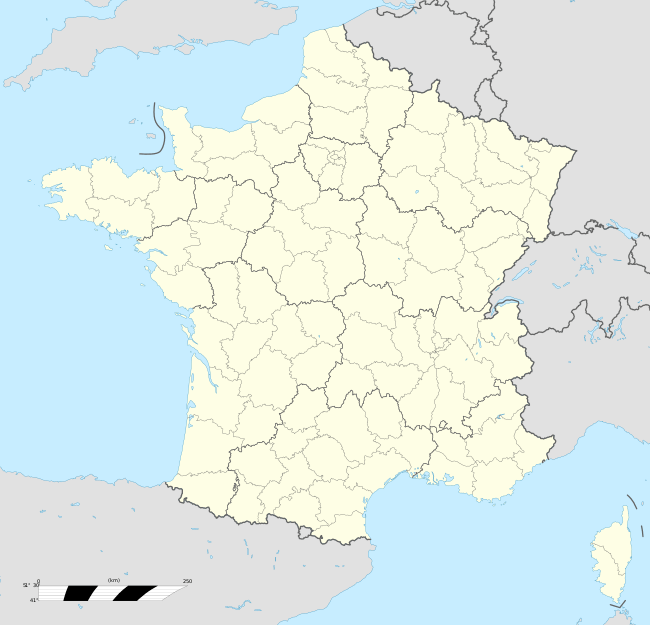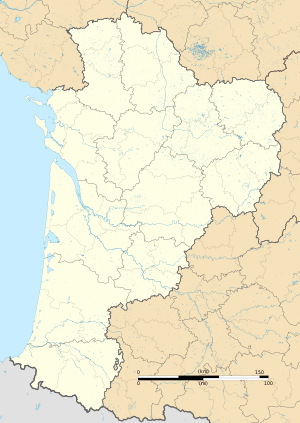Angoulins
| Angoulins | ||
|---|---|---|
| Commune | ||
 Seashore at Angoulins | ||
| ||
 Angoulins Location within Nouvelle-Aquitaine region  Angoulins | ||
| Coordinates: 46°06′18″N 1°06′31″W / 46.105°N 1.108611°WCoordinates: 46°06′18″N 1°06′31″W / 46.105°N 1.108611°W | ||
| Country | France | |
| Region | Nouvelle-Aquitaine | |
| Department | Charente-Maritime | |
| Arrondissement | La Rochelle | |
| Canton | Châtelaillon-Plage | |
| Intercommunality | La Rochelle | |
| Government | ||
| • Mayor (2014-2020) | Daniel Vailleau | |
| Area1 | 7.86 km2 (3.03 sq mi) | |
| Population (2014)2 | 3,800 | |
| • Density | 480/km2 (1,300/sq mi) | |
| Time zone | UTC+1 (CET) | |
| • Summer (DST) | UTC+2 (CEST) | |
| INSEE/Postal code | 17010 /17690 | |
| Elevation |
0–17 m (0–56 ft) (avg. 4 m or 13 ft) | |
|
1 French Land Register data, which excludes lakes, ponds, glaciers > 1 km2 (0.386 sq mi or 247 acres) and river estuaries. 2 Population without double counting: residents of multiple communes (e.g., students and military personnel) only counted once. | ||
Angoulins is a commune in the Charente-Maritime department in the Nouvelle-Aquitaine region of southwestern France.
The inhabitants of the commune are known as Angoulinois or Angoulinoises[1]
Geography
Angoulins is located in the northwest of the department of Charente-Maritime some 8 km south-east of La Rochelle and 5 km north of Châtelaillon-Plage in the former province of Aunis. It is a coastal commune on the Atlantic Ocean. Access is by the E602 (D137) highway from La Rochelle continuing south-east with an exit in the commune just east of Angoulins town. There is also the D202 from Salles-sur-Mer in the east turning south and continuing to Chatelaillon-Plage. Access to the town is by the D111E1 from the D202 on the southern border continuing through the town and turning east to the motorway exit.
Angoulins town has a large urban area occupying almost 50% of the commune with farmland to the north, east, and west.[2]
Geology
The entire commune is located on Jurassic terrain which completely covers the plain of Aunis. Jurassic Marl and limestone outcrops appear on the surface of the commune and the relief is slightly rolling.
The coastal strip of Angoulins, which corresponds to the last extremity of the plain of Aunis, is relatively varied. It alternates between low sandy and marshy shores and high limestone cliffs.
Low-lying coasts, which were formerly salt marshes, have today been transformed into oyster beds (at the marsh north of Chay Point) and are derived from Quaternary sedimentary deposits of marine origin - from the last Flandrian transgression. The sandy coast is situated in a small cove formed naturally by the phenomena of marine erosion and ocean currents (Angoulins beach, south of the Chay point).

The coastal cliffs are located all around the Chay Point and form a limestone peninsula - a sharp promontory jutting into the ocean. Layers of alternating beds of oolitic marl and limestone can be seen on the cliffs that line the coast from La Rochelle to Angoulins-sur-Mer. They are highlighted by thick layers of white rocks alternating with layers of very friable sand and mud, formed during glacial periods, also with layers containing various corals from tropical periods. Chay Point, about five kilometres south of La Rochelle, contains many fossils of marine animals and is an especially famous place of palaeontological studies.
The limestone thus formed is widely used as a building material in traditional houses in the region.
Transport
Railway Stations and Halts
- Aytré (Halt) 3 km
- Châtelaillon-Plage 3.1 km
- La Rochelle (TGV) 6.1 km
- Rochefort 20.7 km
Airports and Aerodromes
- La Rochelle (Laleu) 10.8 km
- Rochefort-St-Agnant 26 km
- Aerodrome of Royan-Médis 54 km
Neighbouring communes and villages[2]
Heraldry
 |
Blazon: Azure, a carrack of Or, sailed in Argent, top castle the same, in chief Gules charged with three mullets of Or. |
Administration
List of Successive Mayors[3]
| From | To | Name | Party | Position |
|---|---|---|---|---|
| 1965 | 1983 | Albert Denis | PCF | |
| 1983 | 1989 | Robert Cassagnes | ||
| 1989 | 2001 | Claude Grenier | SE | |
| 2001 | 2014 | Marie-Claude Bridonneau | PRG | |
| 2014 | 2020 | Daniel Vailleau |
(Not all data is known)
Demography
In 2009 the commune had 3,720 inhabitants. The evolution of the number of inhabitants is known through the population censuses conducted in the commune since 1793. From the 21st century, a census of communes with fewer than 10,000 inhabitants is held every five years, unlike larger towns that have a sample survey every year.[Note 1]
| 1793 | 1800 | 1806 | 1821 | 1831 | 1836 | 1841 | 1846 | 1851 |
|---|---|---|---|---|---|---|---|---|
| 1,647 | 515 | 514 | 617 | 758 | 752 | 753 | 813 | 832 |
| 1856 | 1861 | 1866 | 1872 | 1876 | 1881 | 1886 | 1891 | 1896 |
|---|---|---|---|---|---|---|---|---|
| 824 | 854 | 848 | 733 | 807 | 916 | 1,127 | 1,175 | 1,437 |
| 1901 | 1906 | 1911 | 1921 | 1926 | 1931 | 1936 | 1946 | 1954 |
|---|---|---|---|---|---|---|---|---|
| 718 | 767 | 817 | 706 | 883 | 1,084 | 1,034 | 1,132 | 1,579 |
| 1962 | 1968 | 1975 | 1982 | 1990 | 1999 | 2006 | 2009 | - |
|---|---|---|---|---|---|---|---|---|
| 1,917 | 2,126 | 2,149 | 2,441 | 2,908 | 3,501 | 3,647 | 3,720 | - |
Sources : Ldh/EHESS/Cassini until 1962, INSEE database from 1968 (population without double counting and municipal population from 2006)

According to the INSEE census in 2007, Angoulins had a population of 3,695 (an increase of 6% compared to 1999). The commune was the 2,708th largest at national level, while it was 2,672nd in 1999 and 27th at the departmental level out of 472 communes.
Distribution of Age Groups
The population of the town is relatively old. The rate of people above the age of 60 years (30.8%) is higher than the national rate (21.6%) and the departmental rate (28.1%). As at the national and departmental levels, the female population of the commune is higher than the male population. The percentage (52.3%) is of the same order of magnitude as the national rate (51.6%).
Percentage Distribution of Age Groups in Angoulins and Charente-Maritime Department in 2009
| Angoulins | Angoulins | Charente-M | Charente-M | |
|---|---|---|---|---|
| Age Range | Men | Women | Men | Women |
| 0 to 14 Years | 15.7 | 13.8 | 17.2 | 15.1 |
| 15 to 29 Years | 16.2 | 13.1 | 16.5 | 14.4 |
| 30 to 44 Years | 16.2 | 15.7 | 18.7 | 17.9 |
| 45 to 59 Years | 24.3 | 23.8 | 21.0 | 20.8 |
| 60 to 74 Years | 19.1 | 20.2 | 17.2 | 17.8 |
| 75 to 89 Years | 8.2 | 11.6 | 9.0 | 12.4 |
| 90 Years+ | 0.3 | 1.7 | 0.5 | 1.5 |
Sources:
Economy
There are 12 enterprises in industry, 24 in construction, 83 shops, 37 service enterprises, 2 farms, and 1 shellfish farm. Angoulins is best known for its shopping area.
Sites and Monuments
 The Church of Saint-Peter
The Church of Saint-Peter Fishing Houses
Fishing Houses- Fishing houses
 Angoulins Beach
Angoulins Beach Angoulins Beach
Angoulins Beach
The Church of Saint-Peter (15th century)![]()
Notable people linked to the commune
- Colette Besson, gold medalist in the 400m at the 1968 Summer Olympics in Mexico, died in Angoulins and was buried in the cemetery.[8]
- Father Daniel Brottier, founder of the Foundation of Auteuil, came regularly to spend his summer holidays.
Local associations
- Angoul'Loisirs: Association of Youth and Popular Education founded under the 1901 Act in 1992 which includes different sectors: a Day nursery, a leisure centre, a Youth Projects area, and a Family area.
- Centre Nautique d'Angoulins: An association under the 1901 Act founded in 1976. Originally comprising a handful of enthusiasts and a wooden hut, the association now has more than a hundred members and hosted nearly 2,000 people over the year (windsurfing, catamaran, optimists, etc.). In 1990 an artificial body of water was added to the site. On the night of 27 to 28 February 2010 the Centre Nautique d'Angoulins was badly affected by the storm Xynthia. The buildings were flooded to an average height of 1.60 m. The club had a pontoon for teaching fishing available to rent which was completely destroyed by the storm and is currently under reconstruction.
See also
External links
- Articles on Angoulin's history (in French)
- Angoulins on Lion1906
- Angoulins on Google Maps
- Angoulins on Géoportail, National Geographic Institute (IGN) website (in French)
- Angoulin on the 1750 Cassini Map
- Angoulins on the INSEE website (in French)
- INSEE (in French)
Notes and references
Notes
- ↑ At the beginning of the 21st century, the methods of identification have been modified by law No. 2002-276 of 27 February 2002 Archived 2016-03-06 at the Wayback Machine., the so-called "law of local democracy" and in particular Title V "census operations" which allow, after a transitional period running from 2004 to 2008, the annual publication of the legal population of the different French administrative districts. For communes with a population greater than 10,000 inhabitants, a sample survey is conducted annually, the entire territory of these communes is taken into account at the end of the period of five years. The first "legal population" after 1999 under this new law came into force on 1 January 2009 and was based on the census of 2006.
References
- ↑ Inhabitants of Charente-Maritime (in French)
- 1 2 Google Maps
- ↑ List of Mayors of France
- ↑ Ministry of Culture, Mérimée PA00104591 Church of Saint Peter (in French)

- ↑ Gothic Architecture in Saintonge and Aunis, Yves Blomme, éditions Bordessoules, ISBN 2-903504-33-4 (in French)
- ↑ Ministry of Culture, Palissy PM17000011 Pulpit
(in French)

- ↑ Ministry of Culture, Palissy PM17000010 Bronze Bell (in French)
- ↑ Colette Besson and the values in life for which sport must be the guarantor (in French)
| Wikimedia Commons has media related to Angoulins. |